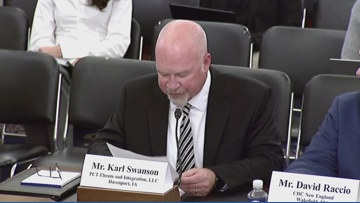Report on Proposed Restructuring of Montgomery County Public Schools Special Programs
Executive Summary
Montgomery County Public Schools (MCPS) has put forth a recommendation to overhaul its secondary education programming by replacing the existing countywide magnet programs and consortia models with a new regional framework. This strategic shift is primarily aimed at enhancing equitable access to specialized education, directly aligning with the United Nations’ Sustainable Development Goals (SDGs), particularly SDG 4 (Quality Education) and SDG 10 (Reduced Inequalities). The proposal, if approved, would phase out prestigious programs at Montgomery Blair and Richard Montgomery High Schools in favor of a decentralized model intended to distribute opportunities more evenly across the county. The new system is slated for implementation by the 2027-2028 academic year.
Analysis of Proposal in Context of Sustainable Development Goals
The proposed changes are fundamentally driven by a commitment to creating a more inclusive and equitable educational system. The current model has been identified as a source of significant disparity, a challenge directly addressed by several key SDGs.
SDG 4: Quality Education
The core objective of the proposal is to advance SDG 4, which calls for inclusive and equitable quality education for all. By moving from a “scarcity model” with a limited number of seats in highly competitive countywide programs to a regional model, MCPS aims to broaden access to high-quality, specialized instruction. The plan ensures that enriched programming in high-demand fields is not confined to a few institutions but is available to students across all geographical regions, thereby enhancing the overall quality and equity of the educational offerings.
SDG 10: Reduced Inequalities
The recommendation directly confronts the challenge of inequality within the county, a central tenet of SDG 10. Current data reveals that enrollment in elite countywide programs is disproportionately composed of Asian and white students. The district acknowledges that a student’s home address or ZIP code currently dictates their access to specialized programs. The regional model is designed to dismantle these geographical and socio-economic barriers, ensuring that all students, regardless of their background, have an equal opportunity to apply for and attend advanced programs.
SDG 11: Sustainable Cities and Communities
In line with SDG 11, the proposal seeks to build more inclusive and sustainable communities. By establishing specialized programs within regional high schools, the plan strengthens local institutions and reduces the need for long-distance travel for a small subset of students. The provision of transportation for all students attending these regional programs further supports SDG Target 11.2, which focuses on providing access to sustainable transport systems for all. This fosters stronger neighborhood schools and more integrated community development.
Details of the Proposed Regional Model
The new framework would restructure the county’s 26 high schools into six distinct regions, with each school offering specialized thematic programming.
Proposed Regional Structure
The six proposed regions would encompass the following high schools:
- Region One: Bethesda-Chevy Chase, Walt Whitman, Montgomery Blair, Albert Einstein, and Northwood.
- Region Two: James Hubert Blake, Springbrook, Paint Branch, and Sherwood.
- Region Three: Walter Johnson, Charles W. Woodward, Wheaton, and John F. Kennedy.
- Region Four: Richard Montgomery, Rockville, Thomas S. Wootton, and Winston Churchill.
- Region Five: Crown, Gaithersburg, Col. Zadok Magruder, Damascus, and Watkins Mill.
- Region Six: Northwest, Clarksburg, Poolesville, Seneca Valley, and Quince Orchard.
Thematic Program Areas
Each high school within a region would offer up to two programs selected from five overarching themes. All schools will continue to provide foundational opportunities, including advanced placement courses and business classes.
- Medical Science and Healthcare
- Science, Technology, Engineering, and Math (STEM)
- International Baccalaureate (IB), Humanities, and Language
- Leadership, Public Service, and Education
- Visual and Performing Arts, Design, and Communication
Application and Enrollment
Students will continue to apply for programs through a centralized MCPS process. Each program is projected to offer between 120 and 260 seats, with allocations adjusted based on student interest and school capacity. A key feature of the model is the preservation of seats for local students who wish to attend the program at their home school, addressing a current issue where local students are often displaced by countywide applicants.
Implementation Framework and Timeline
Transition Plan
The district has proposed a multi-year transition to minimize disruption. Key elements of the plan include:
- Sunset and Ramp-Up: Existing countywide programs will be phased out (“sunsetted”) as the new regional programs are established and expanded.
- Continuity for Current Students: Students currently enrolled in or accepted to a countywide or consortium program will be permitted to complete their studies within that program.
- Target Cohort: The incoming high school class of 2031 will be the first cohort to exclusively utilize the new regional program model.
- Timeline: The superintendent is expected to present a final recommendation for a school board vote by December, with full implementation targeted for the 2027-2028 school year.
Challenges and Considerations
The successful implementation of this model requires addressing several challenges. The concurrent operation of both old and new systems during the transition period is expected to incur significant costs. Furthermore, ensuring an adequate supply of highly qualified educators to staff the new, hyper-specialized programs across all six regions is a critical factor that the district must address in the next phase of planning.
Which SDGs are addressed or connected to the issues highlighted in the article?
SDG 4: Quality Education
- The article is centered on the educational policies of Montgomery County Public Schools (MCPS). The core of the proposal is to restructure specialized high school programs to provide “high quality, enriched programming” to a wider range of students. The plan involves creating new programs in thematic areas like “medical science and healthcare” and “science, technology, engineering and math” to ensure educational quality is not confined to a few select schools.
SDG 10: Reduced Inequalities
- A primary motivation for the proposed changes is to reduce disparities in educational access. The article explicitly states the goal is to “address programming equity” and ensure that “all of our students, regardless of ZIP code, have equitable access.” It highlights existing inequalities, noting that “Asian and white students make up a majority of the students in countywide programs,” and that access “depends on where students live.” The new regional model is a direct policy action aimed at reducing these inequalities.
What specific targets under those SDGs can be identified based on the article’s content?
Target 4.5: By 2030, eliminate gender disparities in education and ensure equal access to all levels of education and vocational training for the vulnerable…
- The article directly addresses the principle of “equal access” by aiming to dismantle a system where opportunities are concentrated. The MCPS proposal seeks to correct a system where “some students have more opportunities to apply to different programs compared to other students.” The focus on racial imbalances in program enrollment and geographic disparities (“regardless of ZIP code”) aligns with the target’s goal of ensuring equal access for all, particularly for students who may be in vulnerable situations due to their location or background.
Target 10.3: Ensure equal opportunity and reduce inequalities of outcome, including by eliminating discriminatory… policies and practices…
- The MCPS initiative is a clear example of a policy change intended to ensure “equal opportunity.” The district is proposing to replace its existing “countywide magnet programs and its consortia model” because this policy has led to “inequalities of outcome,” where students from certain demographics and locations are overrepresented. The article quotes the superintendent saying the old model creates a situation where a student’s “probability of my kid being able to access the program at my kid’s zoned school is diminished greatly.” The new regional model is the “action” being promoted to create a more level playing field.
Are there any indicators mentioned or implied in the article that can be used to measure progress towards the identified targets?
Proportion of students in specialized programs, disaggregated by race and home location (ZIP code/region)
- This indicator is directly implied by the article’s problem statement. It mentions that “Asian and white students make up a majority of the students in countywide programs.” Progress towards equity would be measured by tracking the racial and ethnic demographics of students in the new regional programs to see if they become more representative of the county’s overall student population. Similarly, tracking enrollment by a student’s home ZIP code or region would measure whether the goal of providing access “regardless of ZIP code” is being met.
Number of available seats and program options per region
- The article implies this indicator by describing the proposed solution. The new model would create regional programs that “would initially offer 120 to 260 seats or more for students.” Furthermore, the plan is to have each high school within a region offer “up to two themed programs” from a list of five. An indicator of success would be the total number of seats created and the equitable distribution of diverse, high-quality program themes across all six newly defined regions, ensuring no single region is underserved.
Student transportation access and utilization
- The article mentions that the existing system creates “transportation more complicated for students” and that a key part of the new plan is to “provide transportation for all students who attend them.” An indicator of progress would be the percentage of students in specialized programs who are provided with and utilize district transportation, which would demonstrate that this barrier to access has been effectively removed.
SDGs, Targets, and Indicators Table
| SDGs | Targets | Indicators (Mentioned or Implied in Article) |
|---|---|---|
| SDG 4: Quality Education Ensuring inclusive and equitable quality education and promoting lifelong learning opportunities for all. |
Target 4.5: Ensure equal access to all levels of education and vocational training. |
|
| SDG 10: Reduced Inequalities Reduce inequality within and among countries. |
Target 10.3: Ensure equal opportunity and reduce inequalities of outcome by eliminating discriminatory policies. |
|
Source: bethesdamagazine.com







